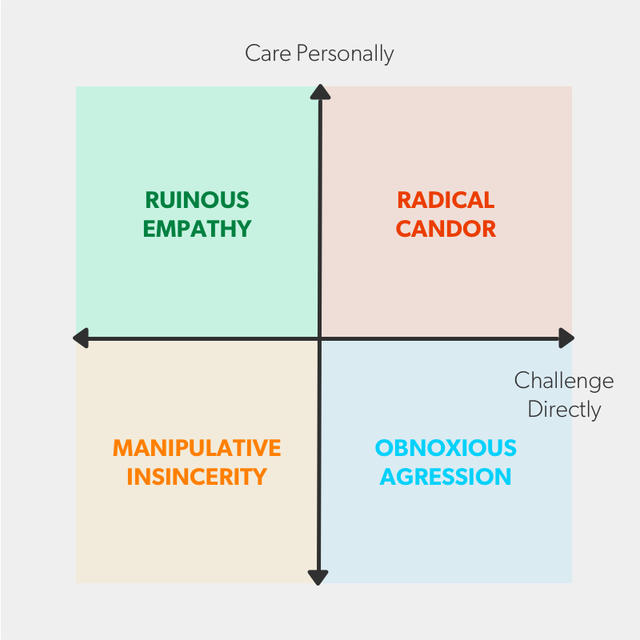If you look above, you’ve basically got four options via Kim Scott, who’s worked at Google and Apple (she directly reported to Sheryl Sandberg at Google, it would appear). Her overall principle is called ‘radical candor,’ and much of how it works is outlined here. There are any number of four-quadrant ideas in American business — here’s an example of one geared towards productivity — and Scott’s works this way:
You have two axises: ‘care personally’ and ‘challenge directly.’ Here are your options:
- When you ‘care personally’ and are able to ‘challenge directly’ (the type of boss many probably would want), that’s radical candor.
- If you ‘care personally’ but don’t ‘challenge directly,’ that’s ruinous empathy.
- If you do neither, that’s ‘manipulative insecurity.’
- If you challenge directly but don’t care, that’s ‘obnoxious aggression.’
So now you come to, essentially, four types of bosses in terms of how they communicate with their employees:
- Radical candor
- Ruinous empathy
- Manipulative insecurity
- Obnoxious aggression
There are flaws to all these models, although radical candor is the best: that means a person legitimately cares about you as a human and an employee with the potential for growth, and sometimes that requires tough conversations to be had as a result.
Most bosses probably fall into the bottom two rungs — manipulative, insecure, obnoxious, or aggressive (or a mix of all four adjectives).
There are a couple of reasons for this, primarily:
- Management isn’t intuitive: Managers become managers by acting a certain way, i.e. focusing on targets/goals set for them by others. When they become managers, they assume the next step is to do exactly the same thing to the people under them. That’s bad, because management is actually about human connection — not targets and deliverables. Managers often don’t realize this, because it’s not intuitive, and a spiral of bad begins.
- Work is not a logical place: We want it to be — which is why we throw process at everything — but work is populated by human beings, who are emotional creatures, not logical ones.
- What is accountability? In reality, it’s an organic discussion about the pros and cons of something you just did with the person who has responsibility for you in a work/corporate sense (your boss). Problem? Most bosses view ‘accountability’ as ‘ripping someone a new asshole.’ That’s a problem.
- Hiding behind reviews: The once-a-year performance review is a massive relic of the Industrial Age of workplaces, but many organizations are still using it. Think about this: if a senior leadership team approves a ‘go-to-market strategy’ and on Day 5 it doesn’t seem to be working, what do you think will happen? Plane tickets are booked, calendars are adjusted, and it’s OFFSITE TIME, baby! Breathless analysis of our positioning and consumer value prop! That’s how fast people respond to concerns about potential revenue hits. So we move super-quick on that side … but we tell our employees how they’re doing and where they stand once a year? That makes no sense. Here’s the dirty little secret: most managers are overwhelmed with their own jobs and can’t set their own priorities, so they hide behind the once-a-year review. When an employee wants/needs/deserves ‘feedback,’ they will say “Oh, that can happen at the review process stage!” It’s the same way managers hide behind HR when making a hire or hide behind consultants when making a tough decision. It’s all an elaborate game of “Who can I toss under a bus for this if it doesn’t work out exactly how I want it to?”
Quick point off the above: basically when we’re talking about managers communicating with employees in one of four ways, we’re also talking about ‘feedback,’ which is a fraught issue at many workplaces. Kim Scott avoids the term ‘feedback’ because it’s buzzword hell and it makes employees groan. I concur with that.
A better word might be guidance, as Scott points out here:
“This is one of the most important things you can do to foster a culture of guidance between the people who work for you,” says Scott. But that means more than squelching obviously political or passive aggressive behavior; bosses also need to avoid acting as well-meaning, but ultimately harmful go-betweens. Scott learned this one the hard way, too, trying to act as diplomat for two reports who couldn’t get along.
One of the core problems here is pretty simple: we promote individuals, but we ask people to work in teams. That’s a major disconnect for the human brain, and so a lot of people focus on their shit, their area, their tasks, their things they understand — and they cling to those, because they want to get ahead. That’s where the concept of ‘guidance’ in most workplaces falls apart, although that should be the goal of any team — curiosity, learning, and shared guidance.
Most employees and managers tend to have an off-focus relationship, for a lot of the reasons I bulleted above. But if you think about two tenets of management as ‘caring’ and ‘challenging,’ and then you think about the four options that can result from the intersection of those two ideas, you’re further ahead than most people — or someone who isn’t thinking about it at all.
What do you think? Are there other ways or models for bosses to communicate with employees?

Reblogged this on Gr8fullsoul.